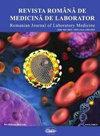COVID-19相关凝血功能障碍与年龄增加和炎症反应标志物相关
IF 0.5
4区 医学
Q4 MEDICINE, RESEARCH & EXPERIMENTAL
引用次数: 2
摘要
背景:2019冠状病毒病(COVID-19)的严重表现与病毒高炎症、细胞因子释放综合征和随后的凝血功能障碍有关。在COVID-19患者中最常见的凝血异常是血浆d -二聚体水平升高。本研究的目的是评估covid -19相关炎症综合征和凝血功能障碍的特征及其与疾病严重程度的相关性。方法:我们进行了一项横断面研究,纳入了2020年3月1日至9月30日期间在罗马尼亚布加勒斯特Matei Bals国家传染病研究所成人3部接受治疗的所有连续COVID-19患者。我们记录临床和流行病学特征、炎症标志物、凝血异常和淋巴细胞计数。使用计算机断层扫描检查评估肺部受累的严重程度。结果:纳入106例SARS-COV2感染患者,其中男性50例(47.2%),女性56例(52.8%),年龄14 ~ 91岁。在我们的研究中,严重疾病患者的所有炎症标志物都增加了,如乳酸脱氢酶、单核细胞分布宽度和中性粒细胞与淋巴细胞的比例。在大约一半的受试者中观察到血清d -二聚体水平升高,并与疾病严重程度相关。我们预测COVID-19凝血功能障碍(表现为d -二聚体水平异常)的最佳线性回归模型包括年龄、纤维蛋白原和淋巴细胞计数。结论:我们的研究结果强调了COVID-19凝血功能障碍与全身性炎症之间的关联。相当比例的中度和重度疾病患者有凝血功能异常,这与炎症的存在和年龄的增长有关。本文章由计算机程序翻译,如有差异,请以英文原文为准。
COVID-19 associated coagulopathy is correlated with increased age and markers of inflammation response
Abstract Background: The severe manifestations of the coronavirus disease 2019 (COVID-19) are linked to viral hyper-inflammation, cytokine release syndrome and subsequent coagulation disturbances. The most common coagulation abnormality observed in COVID-19 patients is the elevation of the plasma levels of D-dimers. The aim of this study was to evaluate the characteristics of COVID-19-associated inflammatory syndrome and coagulopathy, in correlation with disease severity. Methods: We performed a cross-sectional study, enrolling all consecutive COVID-19 patients treated in the Adulti 3 Department of the Prof. Dr. Matei Bals National Institute of Infectious Diseases, Bucharest, Romania, between 1st march and 30th September 2020. We recorded clinical and epidemiological characteristics, inflammatory markers, coagulation abnormalities and lymphocyte count. The severity of lung involvement was assessed using native Computed Tomography examination. Results: We included 106 patients with SARS-COV2 infection, 50 males (47.2%) and 56 females (52.8%), age range 14-91 years. All markers of inflammation were increased in our study in patients with severe disease, as were lactate dehydrogenase, monocyte distribution width, and neutrophil-to-lymphocyte ratio. An elevated level of serum D-dimers was observed in approximately half of our subjects and was associated with disease severity. Our best linear regression model for predicting COVID-19 coagulopathy (manifested as abnormal D-dimer levels) included age, fibrinogen, and lymphocyte count. Conclusion: Our findings emphasize the association between COVID-19 coagulopathy and the presence of systemic inflammation. A significant proportion of patients with moderate and severe disease had coagulation abnormalities and these were linked with the presence of inflammation and older age..
求助全文
通过发布文献求助,成功后即可免费获取论文全文。
去求助
来源期刊

Revista Romana De Medicina De Laborator
MEDICINE, RESEARCH & EXPERIMENTAL-
CiteScore
0.31
自引率
20.00%
发文量
43
审稿时长
>12 weeks
期刊介绍:
The aim of the journal is to publish new information that would lead to a better understanding of biological mechanisms of production of human diseases, their prevention and diagnosis as early as possible and to monitor therapy and the development of the health of patients
 求助内容:
求助内容: 应助结果提醒方式:
应助结果提醒方式:


